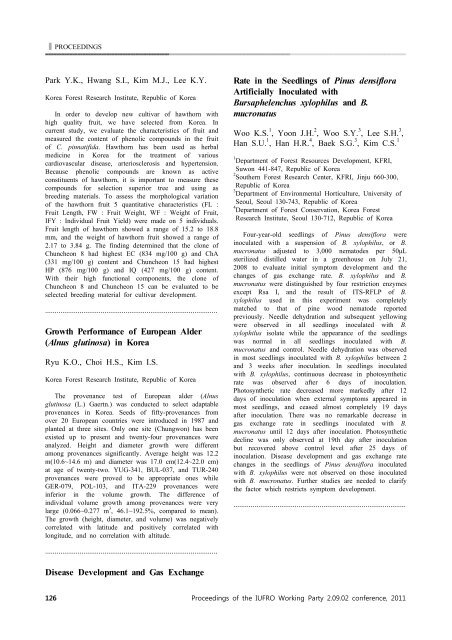Advances in Somatic embryogenesis of Trees and Its - IUFRO
Advances in Somatic embryogenesis of Trees and Its - IUFRO
Advances in Somatic embryogenesis of Trees and Its - IUFRO
You also want an ePaper? Increase the reach of your titles
YUMPU automatically turns print PDFs into web optimized ePapers that Google loves.
PROCEEDINGS<br />
<br />
Park Y.K., Hwang S.I., Kim M.J., Lee K.Y.<br />
Korea Forest Research Institute, Republic <strong>of</strong> Korea<br />
In order to develop new cultivar <strong>of</strong> hawthorn with<br />
high quality fruit, we have selected from Korea. In<br />
current study, we evaluate the characteristics <strong>of</strong> fruit <strong>and</strong><br />
measured the content <strong>of</strong> phenolic compounds <strong>in</strong> the fruit<br />
<strong>of</strong> C. p<strong>in</strong>natifida. Hawthorn has been used as herbal<br />
medic<strong>in</strong>e <strong>in</strong> Korea for the treatment <strong>of</strong> various<br />
cardiovascular disease, arteriosclerosis <strong>and</strong> hypertension.<br />
Because phenolic compounds are known as active<br />
constituents <strong>of</strong> hawthorn, it is important to measure these<br />
compounds for selection superior tree <strong>and</strong> us<strong>in</strong>g as<br />
breed<strong>in</strong>g materials. To assess the morphological variation<br />
<strong>of</strong> the hawthorn fruit 5 quantitative characteristics (FL :<br />
Fruit Length, FW : Fruit Weight, WF : Weight <strong>of</strong> Fruit,<br />
IFY : Individual Fruit Yield) were made on 5 <strong>in</strong>dividuals.<br />
Fruit length <strong>of</strong> hawthorn showed a range <strong>of</strong> 15.2 to 18.8<br />
mm, <strong>and</strong> the weight <strong>of</strong> hawthorn fruit showed a range <strong>of</strong><br />
2.17 to 3.84 g. The f<strong>in</strong>d<strong>in</strong>g determ<strong>in</strong>ed that the clone <strong>of</strong><br />
Chuncheon 8 had highest EC (834 mg/100 g) <strong>and</strong> ChA<br />
(331 mg/100 g) content <strong>and</strong> Chuncheon 15 had highest<br />
HP (876 mg/100 g) <strong>and</strong> IQ (427 mg/100 g) content.<br />
With their high functional components, the clone <strong>of</strong><br />
Chuncheon 8 <strong>and</strong> Chuncheon 15 can be evaluated to be<br />
selected breed<strong>in</strong>g material for cultivar development.<br />
··························································································<br />
Growth Performance <strong>of</strong> European Alder<br />
(Alnus glut<strong>in</strong>osa) <strong>in</strong> Korea<br />
Ryu K.O., Choi H.S., Kim I.S.<br />
Korea Forest Research Institute, Republic <strong>of</strong> Korea<br />
The provenance test <strong>of</strong> European alder (Alnus<br />
glut<strong>in</strong>osa (L.) Gaertn.) was conducted to select adaptable<br />
provenances <strong>in</strong> Korea. Seeds <strong>of</strong> fifty-provenances from<br />
over 20 European countries were <strong>in</strong>troduced <strong>in</strong> 1987 <strong>and</strong><br />
planted at three sites. Only one site (Chungwon) has been<br />
existed up to present <strong>and</strong> twenty-four provenances were<br />
analyzed. Height <strong>and</strong> diameter growth were different<br />
among provenances significantly. Average height was 12.2<br />
m(10.6~14.6 m) <strong>and</strong> diameter was 17.0 cm(12.4~22.0 cm)<br />
at age <strong>of</strong> twenty-two. YUG-341, BUL-037, <strong>and</strong> TUR-240<br />
provenances were proved to be appropriate ones while<br />
GER-079, POL-103, <strong>and</strong> ITA-229 provenances were<br />
<strong>in</strong>ferior <strong>in</strong> the volume growth. The difference <strong>of</strong><br />
<strong>in</strong>dividual volume growth among provenances were very<br />
large (0.066~0.277 m 3 , 46.1~192.5%, compared to mean).<br />
The growth (height, diameter, <strong>and</strong> volume) was negatively<br />
correlated with latitude <strong>and</strong> positively correlated with<br />
longitude, <strong>and</strong> no correlation with altitude.<br />
Rate <strong>in</strong> the Seedl<strong>in</strong>gs <strong>of</strong> P<strong>in</strong>us densiflora<br />
Artificially Inoculated with<br />
Bursaphelenchus xylophilus <strong>and</strong> B.<br />
mucronatus<br />
Woo K.S. 1 , Yoon J.H. 2 , Woo S.Y. 3 , Lee S.H. 3 ,<br />
Han S.U. 1 , Han H.R. 4 , Baek S.G. 3 , Kim C.S. 1<br />
1 Department <strong>of</strong> Forest Resources Development, KFRI,<br />
Suwon 441-847, Republic <strong>of</strong> Korea<br />
2 Southern Forest Research Center, KFRI, J<strong>in</strong>ju 660-300,<br />
Republic <strong>of</strong> Korea<br />
3 Department <strong>of</strong> Environmental Horticulture, University <strong>of</strong><br />
Seoul, Seoul 130-743, Republic <strong>of</strong> Korea<br />
4 Department <strong>of</strong> Forest Conservation, Korea Forest<br />
Research Institute, Seoul 130-712, Republic <strong>of</strong> Korea<br />
Four-year-old seedl<strong>in</strong>gs <strong>of</strong> P<strong>in</strong>us densiflora were<br />
<strong>in</strong>oculated with a suspension <strong>of</strong> B. xylophilus, or B.<br />
mucronatus adjusted to 3,000 nematodes per 50L<br />
sterilized distilled water <strong>in</strong> a greenhouse on July 21,<br />
2008 to evaluate <strong>in</strong>itial symptom development <strong>and</strong> the<br />
changes <strong>of</strong> gas exchange rate. B. xylophilus <strong>and</strong> B.<br />
mucronatus were dist<strong>in</strong>guished by four restriction enzymes<br />
except Rsa I, <strong>and</strong> the result <strong>of</strong> ITS-RFLP <strong>of</strong> B.<br />
xylophilus used <strong>in</strong> this experiment was completely<br />
matched to that <strong>of</strong> p<strong>in</strong>e wood nematode reported<br />
previously. Needle dehydration <strong>and</strong> subsequent yellow<strong>in</strong>g<br />
were observed <strong>in</strong> all seedl<strong>in</strong>gs <strong>in</strong>oculated with B.<br />
xylophilus isolate while the appearance <strong>of</strong> the seedl<strong>in</strong>gs<br />
was normal <strong>in</strong> all seedl<strong>in</strong>gs <strong>in</strong>oculated with B.<br />
mucronatus <strong>and</strong> control. Needle dehydration was observed<br />
<strong>in</strong> most seedl<strong>in</strong>gs <strong>in</strong>oculated with B. xylophilus between 2<br />
<strong>and</strong> 3 weeks after <strong>in</strong>oculation. In seedl<strong>in</strong>gs <strong>in</strong>oculated<br />
with B. xylophilus, cont<strong>in</strong>uous decrease <strong>in</strong> photosynthetic<br />
rate was observed after 6 days <strong>of</strong> <strong>in</strong>oculation.<br />
Photosynthetic rate decreased more markedly after 12<br />
days <strong>of</strong> <strong>in</strong>oculation when external symptoms appeared <strong>in</strong><br />
most seedl<strong>in</strong>gs, <strong>and</strong> ceased almost completely 19 days<br />
after <strong>in</strong>oculation. There was no remarkable decrease <strong>in</strong><br />
gas exchange rate <strong>in</strong> seedl<strong>in</strong>gs <strong>in</strong>oculated with B.<br />
mucronatus until 12 days after <strong>in</strong>oculation. Photosynthetic<br />
decl<strong>in</strong>e was only observed at 19th day after <strong>in</strong>oculation<br />
but recovered above control level after 25 days <strong>of</strong><br />
<strong>in</strong>oculation. Disease development <strong>and</strong> gas exchange rate<br />
changes <strong>in</strong> the seedl<strong>in</strong>gs <strong>of</strong> P<strong>in</strong>us densiflora <strong>in</strong>oculated<br />
with B. xylophilus were not observed on those <strong>in</strong>oculated<br />
with B. mucronatus. Further studies are needed to clarify<br />
the factor which restricts symptom development.<br />
··························································································<br />
··························································································<br />
Disease Development <strong>and</strong> Gas Exchange


